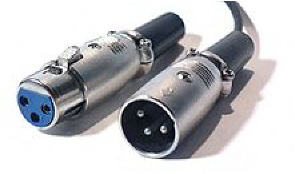Important concepts in audio
Preamplifiers
The signal from a microphone is of low voltage. This signal needs to be amplified prior to further processing, like mixing or recording. This is done with a preamplifier. The strength of the signal that is amplified this way, is called line-level. When you subsequently connect the preamplifier to the sound card of your computer, select Line in when a message pops up that a new devices is detected.
The unamplified signal is very sensitive to noise. Therefore the preamplifier should be positioned as close to the microphone as possible.
When you use a digital video device and connect the audio directly to the sound card of the computer, the sound card of the computer functions as a preamplifier. So for recordings with digital devices, you can connect the microphone directly to the computer. When a message pops up that a new device is detected, select Mic-in as input source.
Balanced cables
In professional audio, a balanced line or balanced signal pair is a transmission line consisting of two conductors of the same type. Both lines have equal impedances along their lengths and equal impedances to ground and to other circuits. Both lines are twisted together and then wrapped with a third conductor (foil or braid) that acts as a shield. Common balanced cables are cables with XLR connectors. Balanced cables are the opposite of unbalanced cables. A coaxial cable is an example of an unbalanced cable.
The main advantage of the use of balanced lines is good rejection of external noise. Because the signal between the microphones and preamplifier is most sensitive to noise, it is most important to use balanced lines there.
Phantom power
Phantom power, often indicated with P48, is a method to supply condenser microphones with power through microphone cables. Condenser microphones give better audio quality than other types of microphones, but they are more sensitive to noise. Preamplifiers and mixers can often supply microphones with phantom power.
Gain
The gain of a preamplifier is the degree to which the amplifier magnifies the low-level input signal compared to its output signal. It is the ratio of the output voltage divided by the input voltage and is expressed in decibels (dB). The formula to calculate gain is 20 x Log (Voltage output/Voltage input). A gain of 6 dB doubles the voltage 2 times and a gain of 20 dB gives a 10 fold increase in the signal.
Gain trim
For some amplifiers the gain can be selected in ranges. For example a LOW gain, gives a range from 18 to 38 dB. With the switch Gain trim, you can select the actual gain.
High pass filter
A high-pass filter (HPF) is a device in a preamplifier that passes high frequencies. Therefore it reduces the amplitude of frequencies lower than its cutoff frequency. It is sometimes called a low-cut filter or bass-cut filter.

No Comments